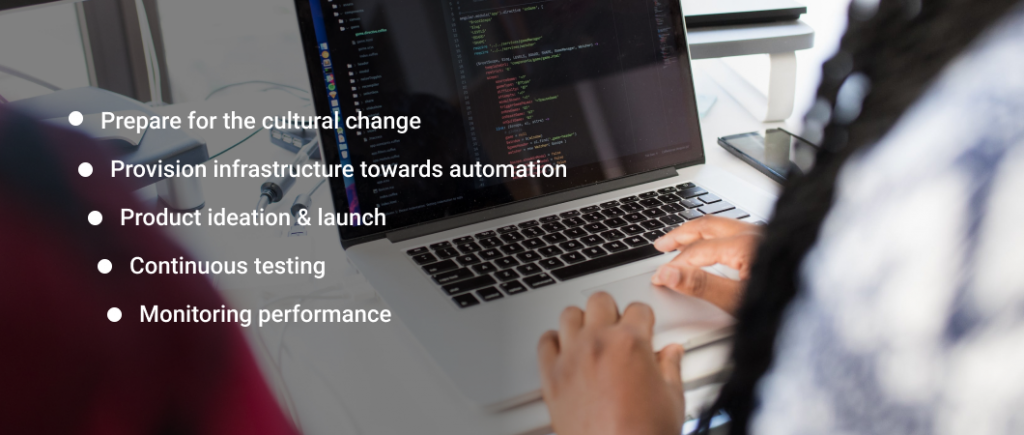Last updated on July 28th, 2023
In today’s software development landscape, where agility is paramount, DevOps has emerged as an even faster and more polished incarnation of Agile. Renowned for its ability to shorten development cycles, maintain high software quality, and facilitate collaboration between development, testing, and operational teams, DevOps has become the darling of the software development industry. Undoubtedly, DevOps holds the potential to drive business transformation at an accelerated pace.
The primary objective of a DevOps initiative is to enhance time-to-market, reduce costs, minimize errors and bugs, and establish a stable operational environment. However, as businesses embark on this journey of DevOps transformation, they may encounter a set of challenges that can significantly impact the success of their implementation.
According to a study conducted in 2018, global DevOps adoption among software teams rose from 10% to 17% in a year, and this growth trend continues. Nevertheless, it was also observed that 15% of companies were contemplating adoption but faced certain obstacles hindering their progress.
Given that a DevOps initiative brings about changes to the core business processes, it is crucial to approach the DevOps journey with mindfulness and prioritize it as the initial stage of implementation.
Let’s delve into how you can meticulously plan and ensure the success of your DevOps initiative by comprehending your existing business processes and tailoring them to align with DevOps principles.
How to Kickstart Your DevOps Initiative
- Embrace Cultural Change DevOps represents an organizational transformation that cannot be overlooked. As it redefines the end-to-end delivery model, embracing a cultural shift becomes imperative for a smooth transition to DevOps. Introducing burdensome policies and time-consuming learning materials will only hinder progress. Cooperation, coordination, and transformation across all workforce levels are vital for harmony. To achieve this, prepare for cultural change by establishing a dedicated change management team, enlisting domain experts to guide the adoption stages, and facilitating extensive knowledge transfer to enhance understanding of business processes and responsiveness to business needs.
- Automate Infrastructure Provisioning Once your organization is culturally prepared for change, the next step is to assess whether your existing business infrastructure can adequately support DevOps automation. Determine the infrastructure requirements by evaluating the current state of devices and systems, build an infrastructure that aligns with automation needs, and ensure it is ready for automation. Key actions at this stage of your DevOps adoption plan should include automating infrastructure provisioning, selecting appropriate tools and infrastructure, and smoothly transitioning from traditional operations-based infrastructure to a fully automated environment.
- Ideate and Launch Products While the infrastructure is being developed, it is vital to identify business goals, pinpoint pain points to be addressed, establish key performance indicators, and assess associated risks. This information will shape your product development plan. Engage key stakeholders to ensure comprehensive groundwork, continuous integration, and delivery. With a DevOps-ready infrastructure, the production team can adopt a “build and run” approach, enabling quick iterations and the creation of an automated deployment platform.
- Implement Continuous Testing One of the significant advantages of adopting DevOps is achieving error-free code. Continuous testing must be implemented at all stages to ensure this. In DevOps, testing is an integral part of development, working in synergy with production to minimize downtime and reduce the time between check-ins and releases. The DevOps (or DevTestOps) team should undertake Smoke, Manual, Regression, Adhoc, and Exploratory Testing to troubleshoot errors and bugs continuously, alongside development and deployment.
- Monitor Performance Establishing monitoring and log analysis tools is essential for measuring development velocity, the number of code changes, bug occurrences, severity levels, and MTTR (mean time to repair). These metrics provide insights into the effectiveness of your DevOps plan. Additionally, measuring infrastructure efficiency and server health is crucial. Monitoring resource usage, application performance, and compliance with regulatory standards are equally important.
How to Make DevOps Work for You
The aforementioned pointers serve as an excellent starting point for your DevOps initiatives. While the results of DevOps adoption may seem fascinating, the journey itself can be challenging without professional guidance. DevOps has evolved beyond a mere methodology, and to ensure its success in your organization, it is highly recommended to choose a reliable DevOps adoption partner. Such a partner can assist you in setting up infrastructure, driving cultural change, facilitating ideation and product launches, and providing essential testing and monitoring tools.
Ready to embark on your successful DevOps journey? Contact Forgeahead Solutions, your trusted DevOps partner, to unlock the full potential of DevOps in your organization.



